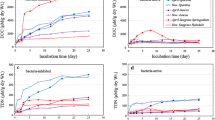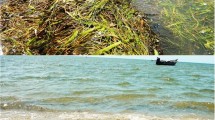Abstract
Dissolved organic matter (DOM) represents a significant source of nutrients that supports the microbial-based food web in seagrass ecosystems. However, there is little information on how the various fractions of DOM from seagrass leaves contributed to the coastal biogeochemical cycles. To address this gap, we carried out a 30-day laboratory chamber experiment on tropical seagrasses Thalassia hemprichii and Enhalus acoroides. After 30 days of incubation, on average 22% carbon (C), 70% nitrogen (N) and 38% phosphorus (P) of these two species of seagrass leaf litter was released. The average leached dissolved organic carbon (DOC), dissolved organic nitrogen (DON) and dissolved organic phosphorus (DOP) of these two species of seagrass leaf litter accounted for 55%, 95% and 65% of the total C, N and P lost, respectively. In the absence of microbes, about 75% of the total amount of DOC, monosaccharides (MCHO), DON and DOP were quickly released via leaching from both seagrass species in the first 9 days. Subsequently, little DOM was released during the remainder of the experiment. The leaching rates of DOC, DON and DOP were approximately 110, 40 and 0.70 µmol/(g·d). Leaching rates of DOM were attributed to the nonstructural carbohydrates and other labile organic matter within the seagrass leaf. Thalassia hemprichii leached more DOC, DOP and MCHO than E. acoroides. In contrast, E. acoroides leached higher concentrations of DON than T. hemprichii, with the overall leachate also having a higher DON: DOP ratio. These results indicate that there is an overall higher amount of DOM leachate from T. hemprichii than that of E. acoroides that is available to the seagrass ecosystem. According to the logarithmic model for DOM release and the in situ leaf litter production (the Xincun Bay, South China Sea), the seagrass leaf litter of these two seagrass species could release approximately 4×103 mol/d DOC, 1.4×103 mol/d DON and 25 mol/d DOP into the seawater. In addition to providing readily available nutrients for the microbial food web, the remaining particulate organic matter (POM) from the litter would also enter microbial remineralization processes. What is not remineralized from either DOM or POM fractions has potential to contribute to the permanent carbon stocks.
Similar content being viewed by others

References
Allen S E. 1989. Chemical Analysis of Ecological Materials. Oxford: Blackwell Scientific Publications
Aminot A, Kérouel R. 2004. Dissolved organic carbon, nitrogen and phosphorus in the N–E Atlantic and the N–W Mediterranean with particular reference to non–refractory fractions and degradation. Deep Sea Res Part I Oceanogr Res Pap, 51(12): 1975–1999
Apostolaki E T, Marbà N, Holmer M, et al. 2009. Fish farming enhances biomass and nutrient loss in Posidonia oceanica (L.) Delile. Estuar Coast Shelf Sci, 81(3): 390–400
Barrón C, Duarte C M. 2009. Dissolved organic matter release in a Posidonia oceanica meadow. Mar Ecol Prog Ser, 374: 75–84
Bronk D A, Lomas M W, Glibert P M, et al. 2000. Total dissolved nitrogen analysis: comparisons between the persulfate, UV and high temperature oxidation methods. Mar Chem, 69(1–2): 163–178
Burke M K, Dennison W C, Moore K A. 1996. Non–structural carbohydrate reserves of eelgrass Zostera marina. Mar Ecol Prog Ser, 137: 195–201
Cebrian J, Duarte C M. 2001. Detrital stocks and dynamics of the seagrass Posidonia oceanica (L.) Delile in the Spanish Mediterranean. Aquat Bot, 70(4): 295–309
Cebrián J, Duarte C M, Marbà N, et al. 1996. Herbivory on Posidonia oceanica: magnitude and variability in the Spanish Mediterranean. Mar Ecol Prog Ser, 130: 147–155
Chiu S H, Huang Y H, Lin H J. 2013. Carbon budget of leaves of the tropical intertidal seagrass Thalassia hemprichii. Estuar Coast Shelf Sci, 125: 27–35
Collier C J, Lavery P S, Ralph P J, et al. 2009. Shade–induced response and recovery of the seagrass Posidonia sinuosa. J Exp Mar Biol Ecol, 370(1–2): 89–103
Dawes C, Chan M, Chinn R, et al. 1987. Proximate composition, photosynthetic and respiratory responses of the seagrass Halophila engelmannii from Florida. Aquat Bot, 27(2): 195–201
Duarte C M. 1990. Seagrass nutrient content. Mar Ecol Prog Ser, 67: 201–207
Duarte C M, Chiscano C L. 1999. Seagrass biomass and production: a reassessment. Aquat Bot, 65(1–4): 159–174
Duarte C M, Krause–Jensen D. 2017. Export from seagrass meadows contributes to marine carbon sequestration. Front Mar Sci, 4: 13
Duarte C M, Marbà N, Gacia E, et al. 2010. Seagrass community metabolism: assessing the carbon sink capacity of seagrass meadows. Globa Biogeochem Cycles, 24(4): GB4032
Duarte C M, Merino M, Agawin N S R, et al. 1998. Root production and belowground seagrass biomass. Mar Ecol Prog Ser, 171: 97–108
Fourqurean J W, Zieman J C, Powell G V N. 1992. Phosphorus limitation of primary production in Florida Bay: evidence from C:N:P ratios of the dominant seagrass Thalassia testudinum. Limnol Oceanogr, 37(1): 162–171
Godshalk G L, Wetzel R G. 1978. Decomposition of aquatic angiosperms. III. Zostera marina L. and a conceptual model of decomposition. Aquat Bot, 5: 329–354
Grasshoff K, Kremling K, Ehrhardt M. 2009. Methods of Seawater Analysis. 3rd ed. New York: John Wiley & Sons
Harrison P G. 1989. Detrital processing in seagrass systems: a review of factors affecting decay rates, remineralization and detritivory. Aquat Bot, 35(3–4): 263–288
Harrison P G, Mann K H. 1975. Detritus formation from eelgrass (Zostera marina L.): the relative effects of fragmentation, leaching, and decay. Limnol Oceanogr, 20(6): 924–934
Hemminga M A, Duarte C M. 2000. Seagrass Ecology. Cambridge: Cambridge University Press
Hemminga M A, Marbà N, Stapel J. 1999. Leaf nutrient resorption, leaf lifespan and the retention of nutrients in seagrass systems. Aquat Bot, 65(1–4): 141–158
Holmer M, Olsen A B. 2002. Role of decomposition of mangrove and seagrass detritus in sediment carbon and nitrogen cycling in a tropical mangrove forest. Mar Ecol Prog Ser, 230: 87–101
Huang Xiaoping, Huang Liangmin, Li Yinghong, et al. 2006. Main seagrass beds and threats to their habitats in the coastal sea of South China. Chin Sci Bull, 51(S2): 136–142
Invers O, Kraemer G P, Pérez M, et al. 2004. Effects of nitrogen addition on nitrogen metabolism and carbon reserves in the temperate seagrass Posidonia oceanica. J Exp Mar Biol Ecol, 303(1): 97–114
Jiménez M A, Beltran R, Traveset A, et al. 2017. Aeolian transport of seagrass (Posidonia oceanica) beach–cast to terrestrial systems. Estuar Coast Shelf Sci, 196: 31–44
Kirkman H, Reid D D. 1979. A study of the role of the seagrass Posidonia australis in the carbon budget of an estuary. Aquat Bot, 7: 173–183
Lavery P S, McMahon K, Weyers J, et al. 2013. Release of dissolved organic carbon from seagrass wrack and its implications for trophic connectivity. Mar Ecol Prog Ser, 494: 121–133
Lawler I R, Aragones L, Berding N, et al. 2006. Near–infrared reflectance spectroscopy is a rapid, cost–effective predictor of seagrass nutrients. J Chem Ecol, 32(6): 1353–1365
Lee K S, Dunton K H. 1996. Production and carbon reserve dynamics of the seagrass Thalassia testudinum in Corpus Christi Bay, Texas, USA. Mar Ecol Prog Ser, 143: 201–210
Liu Songlin, Jiang Zhijian, Zhang Jingping, et al. 2016a. Effect of nutrient enrichment on the source and composition of sediment organic carbon in tropical seagrass beds in the South China Sea. Mar Pollut Bull, 110(1): 274–280
Liu Songlin, Jiang Zhijian, Zhou Chenyuan, et al. 2016b. Temporal and spatial variation of dissolved organic matter and its controlling factors in seagrass bed ecosystem of Xincun Bay, Hainan Island. Chinese Journal of Ecology (in Chinese), 35(8): 2144–2151
Longstaff B J, Loneragan N R, O’Donohue M J, et al. 1999. Effects of light deprivation on the survival and recovery of the seagrass Halophila ovalis (R.Br.) Hook. J Exp Mar Biol Ecol, 234(1): 1–27
Mackey P, Collier C J, Lavery P S. 2007. Effects of experimental reduction of light availability on the seagrass Amphibolis griffithii. Mar Ecol Prog Ser, 342: 117–126
Maie N, Jaffé R, Miyoshi T, et al. 2006. Quantitative and qualitative aspects of dissolved organic carbon leached from senescent plants in an oligotrophic wetland. Biogeochemistry, 78(3): 285–314
Mateo M A, Romero J. 1996. Evaluating seagrass leaf litter decomposition: an experimental comparison between litter–bag and oxygen–uptake methods. J Exp Mar Biol Ecol, 202(2): 97–106
Mateo M A, Cebrián J, Dunton K, et al. 2006. Carbon flux in seagrass ecosystems. In: Larkum A W D, Orth R J, Duarte C M, eds. Seagrasses: Biology, Ecology and Conservation. Dordrecht: Springer, 159–192
Myklestad S M, Skånøy E, Hestmann S. 1997. A sensitive and rapid method for analysis of dissolved mono–and polysaccharides in seawater. Mar Chem, 56(3–4): 279–286
Ogawa H, Tanoue E. 2003. Dissolved organic matter in oceanic waters. J Oceanogr, 59(2): 129–147
Olivé I, Brun F G, Vergara J J, et al. 2007. Effects of light and biomass partitioning on growth, photosynthesis and carbohydrate content of the seagrass Zostera noltii Hornem. J Exp Mar Biol Ecol, 345(2): 90–100
Orth R J, Moore K A. 1986. Seasonal and year–to–year variations in the growth of Zostera marina L. (eelgrass) in the lower Chesapeake Bay. Aquat Bot, 24(4): 335–341
Peduzzi P, Herndl G J. 1991. Decomposition and significance of seagrass leaf litter (Cymodocea nodosa) for the microbial food web in coastal waters (Gulf of Trieste, northern Adriatic Sea). Mar Ecol Prog Ser, 71(2): 163–174
Pierzynski G M. 2000. Methods of phosphorus analysis for soils, sediments, residuals, and waters. Raleigh: North Carolina State University
Robertson M L, Mills A L, Zieman J C. 1982. Microbial synthesis of detritus–like particulates from dissolved organic carbon released by tropical seagrasses. Mar Ecol Prog Ser, 7: 279–285
Sheppard J K, Lawler I R, Marsh H. 2007. Seagrass as pasture for seacows: landscape–level dugong habitat evaluation. Estuar Coast Shelf Sci, 71(1–2): 117–132
Siegal–Willott J L, Harr K, Hayek L A C, et al. 2010. Proximate nutrient analyses of four species of submerged aquatic vegetation consumed by Florida manatee (Trichechus manatus latirostris) compared to romaine lettuce (Lactuca sativa var. longifolia). J Zoo Wildl Med, 41(4): 594–602
Trevathan–Tackett S M, Macreadie P I, Sanderman J, et al. 2017. A global assessment of the chemical recalcitrance of seagrass tissues: implications for long–term carbon sequestration. Front Plant Sci, 8: 925
Vähätalo A V, Søndergaard M. 2002. Carbon transfer from detrital leaves of eelgrass (Zostera marina) to bacteria. Aquat Bot, 73(3): 265–273
Valderrama J C. 1981. The simultaneous analysis of total nitrogen and total phosphorus in natural waters. Mar Chem, 10(2): 109–122
Vichkovitten T, Holmer M. 2004. Contribution of plant carbohydrates to sedimentary carbon mineralization. Org Geochem, 35(9): 1053–1066
Vizzini S, Sarà G, Michener R H, et al. 2002. The role and contribution of the seagrass Posidonia oceanica (L.) Delile organic matter for secondary consumers as revealed by carbon and nitrogen stable isotope analysis. Acta Oecol, 23(4): 277–285
Wang Xuchen, Chen R F, Cable J E, et al. 2014. Leaching and microbial degradation of dissolved organic matter from salt marsh plants and seagrasses. Aquat Sci, 76(4): 595–609
Yarbro L A, Carlson Jr P R. 2008. Community oxygen and nutrient fluxes in seagrass beds of Florida Bay, USA. Estuar Coasts, 31(5): 877–897
Yemm E W, Willis A J. 1954. The estimation of carbohydrates in plant extracts by anthrone. Biochem J, 57(3): 508–514
Ziegler S, Benner R. 1999. Dissolved organic carbon cycling in a subtropical seagrass–dominated lagoon. Mar Ecol Prog Ser, 180: 149–160
Ziegler S, Kaiser E, Benner R. 2004. Dynamics of dissolved organic carbon, nitrogen and phosphorus in a seagrass meadow of Laguna Madre, Texas. Bull Mar Sci, 75(3): 391–407
Author information
Authors and Affiliations
Corresponding author
Additional information
Foundation item: The National Basic Research Program of China under contract Nos 2015CB452905 and 2015CB452902; the National Natural Science Foundation of China under contract No. 41730529; the National Specialized Project of Science and Technology under contract No. 2015FY110600.
Rights and permissions
About this article
Cite this article
Liu, S., Jiang, Z., Zhou, C. et al. Leaching of dissolved organic matter from seagrass leaf litter and its biogeochemical implications. Acta Oceanol. Sin. 37, 84–90 (2018). https://doi.org/10.1007/s13131-018-1233-1
Received:
Accepted:
Published:
Issue Date:
DOI: https://doi.org/10.1007/s13131-018-1233-1



